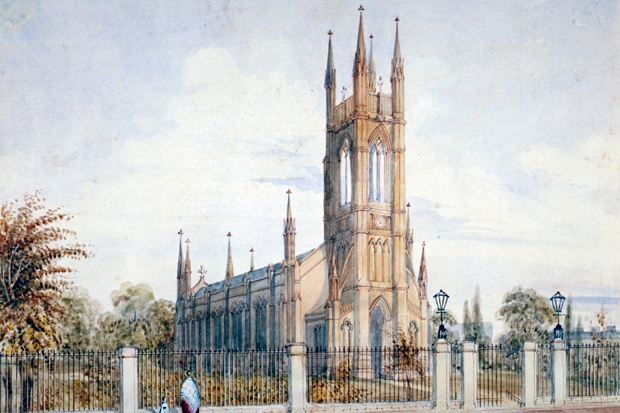The Parish Church of St Luke in Sydney Street, Chelsea, is enormous. Vaguely reminiscent of King’s College Chapel, Cambridge, it was built in the 1820s to accommodate a congregation of 2,500 people and was one of the earliest Gothic Revival churches in London, with a higher nave than any church in the capital other than St Paul’s Cathedral and Westminster Abbey. It was built at great expense with the help of a government subsidy as a result of the Church Building Act of 1818, by which Parliament allocated funds for building new churches in the urban areas of Britain where populations had greatly outgrown the facilities for Christian worship.
Chelsea was one such area, and its then rector, the Revd Gerald Valerian Wellesley, brother of the first Duke of Wellington, pressed hard for St Luke’s construction. He considered his existing parish church — now Chelsea Old Church — too small for his purposes; but he might also have been influenced by a then widely held belief that the Church of England should be strengthened as a bulwark against the sort of revolutionary upheavals that France had recently endured.
In any event, the church got built. Charles Dickens was married there in 1836, just after publishing the first part of The Pickwick Papers; and one of its organists, Sir John Goss (1800–1880), composed two very well-known Anglican hymns, ‘Praise, My Soul, the King of Heaven’ and ‘See, Amid the Winter Snow’. And there St Luke’s still stands, a great edifice in Bath stone — turrets, pinnacles, flying buttresses and all — towering over its surroundings and visible from far and wide.
Well, Chelsea, as we know, is now heavily populated by rich Russians, international bankers, hedge fund managers and so on, who may not regularly attend an Anglican church; and it may be, that despite its ‘outreach’ activities, Café Portico and so on, St Luke’s may sometimes have difficulty filling its pews. I don’t know. What I do know, however, is that there was an impressive turnout for a service I attended there on the Wednesday of Holy Week.
Parallel with Sydney Street, behind the back of the church, is a road of little terraced cottages called St Luke’s Street. And for many decades, in a cottage immediately facing the east end of St Luke’s, lived a woman about as remote from Russian oligarchy as it would be possible to imagine — a relic, if you like (though relic sounds quite the wrong word to describe such a vital, youthful and beautiful woman), of a kinder, cosier, more English place than Chelsea has since become. She was Anne Westwood, the grandmother of my ten-year-old daughter Freya, and it was her funeral that I attended last week.
Anne’s death on 9 March came as a terrible shock. She had been a very young-looking 70, apparently in excellent health, when an infection followed by septicaemia suddenly took her away. Her son Mark and her daughter Emily, Freya’s mother, and Freya herself were shattered. Anne, one of nature’s carers, had spent decades looking after two ailing husbands until both had died. There had been good reason to expect that she would have many happy years ahead of her. But they would have been more caring years, for Anne’s instinctive empathy with others, her ability to help them, and their appreciation of this help, were actually the things that made her the most happy.
Freya, her granddaughter, in a tribute from the pulpit of St Luke’s, declared: ‘I could tell her anything, big or small; she was a brilliant listener. This was one of her greatest qualities.’ Her son Mark recalled that, although of English land-owning stock, she had been born and spent her childhood in South Africa. ‘Coming of age in the bitter years of apartheid undoubtedly fostered her hatred of injustice, her contempt for aggression, her instinctive egalitarianism,’ he said, adding that much of her extraordinary warmth, kindness and compassion had flowed from the selfless care she had received from her African nanny, Elizabeth.
Back in Chelsea, needing money, she took a part-time weeding job that led rapidly to her appointment as head gardener of Thurloe Square and then of other squares — Markham Square, Paultons Square, and Kensington Square among them. She engaged loyal helpers that others might have rejected as down-and-outs, for she believed, in Mark’s words, ‘that everyone, no matter from where they came, was equal, and that anyone, however unlikely, deserved a chance’. And there they all were, hundreds of them at her funeral — old Chelsea friends, people of all kinds whom she had helped or befriended, including those from Wandsworth Prison, where she worked for many years as a visitor — and not a Russian oligarch among them.






Comments